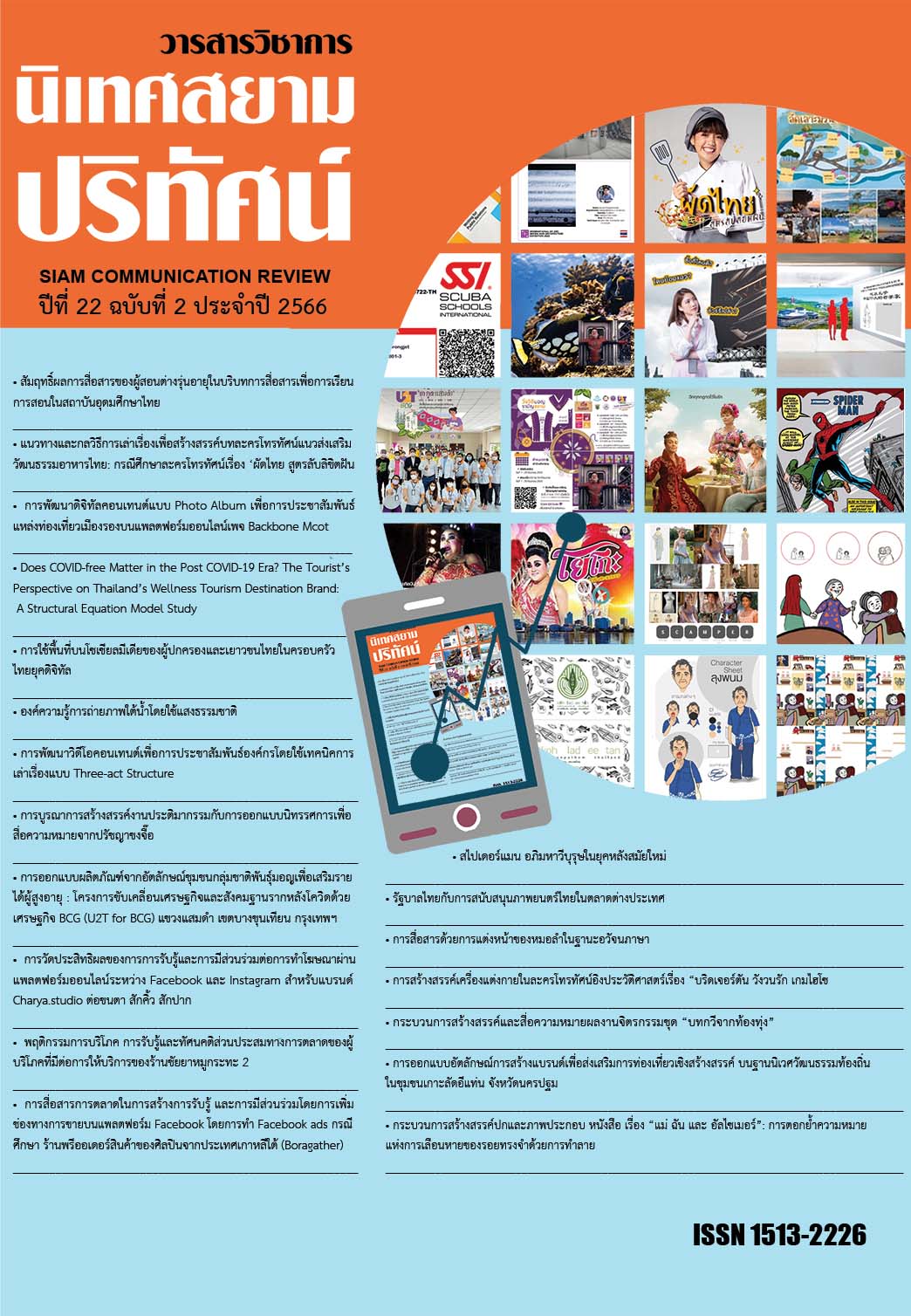Assessing the Effectiveness of Inter-generational Communication between Teachers in the Context of Communication for Learning in Thai Institutions of Higher Education
Main Article Content
Abstract
This study is a qualitative research that aims to investigate the perceptions of students regarding the communication skills of teachers of different ages in the context of teaching and learning in higher education institutions in Thailand. Data was collected through the use of focus group discussions with fourth-year students who were 20 years of age or older and had experience studying with teachers of varying generations. The sample group consisted of 18 participants, who were selected from three different fields: social sciences and humanities (6 participants), science and technology (6 participants), and vocational education (6 participants). The communication abilities of teachers of different ages were evaluated based on the following criteria: 1) Communication proficiency, 2) Communication satisfaction, 3) Recognition of communication difficulties between the teacher and student, and 4) Student response.
Article Details

This work is licensed under a Creative Commons Attribution-NonCommercial-NoDerivatives 4.0 International License.
References
ชัยวัฒน์ โรจน์สุรกิตติ. (2561). การพัฒนากรอบแนวคิดความสามารถในการสื่อสารเชิงอารมณ์ของบุคลากรต่างรุ่นในองค์กรไทย. (วิทยานิพนธ์มหาบัณฑิต). จุฬาลงกรณ์มหาวิทยาลัย, คณะนิเทศศาสตร์.
ณัฏฐ์ชุดา วิจิตรจามรี. (2553). การสื่อสารในองค์กร. กรุงเทพฯ: สำนักพิมพ์มหาวิทยาลัยเกษตรศาสตร์.
เติมศักดิ์ คทวณิช. (2546). จิตวิทยาทั่วไป. กรุงเทพฯ: ซีเอ็ดยูเคชั่น.
นงลักษณ์ ศรีอัษฎาพร เจริญงาม. (2541). ความสามารถในการสื่อสาร: แนวคิดเชิงวัฒนธรรมในองค์กรไทย. โลกของสื่อ,1(2)
นงลักษณ์ ศรีอัษฎาพร เจริญงาม. (2541). ความสามารถในการสื่อสารแนวคิดเชิงนิเวศในองค์กร. วารสารนิเทศศาสตร์, 18(4), 1-18.
ปภัสสรา ชัยวงศ์. (2557). กรอบแนวคิดเชิงทฤษฎีความสามารถในการสื่อสารระหว่างบุคลากรต่างรุ่นในองค์กรไทย. (วิทยานิพนธ์ปริญญาดุษฎีบัณฑิต). จุฬาลงกรณ์มหาวิทยาลัย, คณะนิเทศศาสตร์.
พิบูล ทีปะปาล. (2545). การโฆษณาและการส่งเสริมการขาย. กรุงเทพฯ: มิตรสัมพันธ์กราฟฟิค.
เมตตา วิวัฒนานุกูล (กฤตวิทย์). (2551). สถานภาพการศึกษาการสื่อสารระหว่างวัฒนธรรม ระหว่างปี 2540-
รายงานการวิจัย. คณะนิเทศศาสตร์, จุฬาลงกรณ์มหาวิทยาลัย.
เมตตา วิวัฒนานุกูล (กฤตวิทย์). (2559). การสื่อสารระหว่างวัฒนธรรม. กรุงเทพฯ: สำนักพิมพ์แห่งจุฬาลงกรณ์ มหาวิทยาลัย.
มหาวิทยาลัยสุโขทัยธรรมาธิราช. (2556). การพัฒนาเครื่องมือวัดด้านเจตพิสัยและทักษะพิสัย. นนทบุรี:
มหาวิทยาลัยสุโขทัยธรรมาธิราช.
วิรุฬ พรรณเทวี. (2542). ความพึงพอใจของประชาชนต่อการให้บริการของหน่วยงานกระทรวงมหาดไทยในอําเภอเมืองจังหวัดแม่ฮ่องสอน. (วิทยานิพนธ์ปริญญามหาบัณฑิต). มหาวิทยาลัยเชียงใหม่, คณะศึกษาศาสตร์.
สิทธิ์ ธีรสรณ์. (2552). การสื่อสารทางการตลาด. กรุงเทพฯ: จุฬาลงกรณ์มหาวิทยาลัย.
สมยศ นาวีการ. (2549). การบริหารและพฤติกรรมองค์การ (พิมพ์ครั้งที่ 4). กรุงเทพฯ: บรรณกิจ.
ภัสสราณัฐ รวยธนาสมบัติ. (2558). การศึกษาพฤติกรรมและปัจจัยที่ส่งผลให้เกิดความตั้งใจซื้อสินค้าผ่านอินเทอร์เน็ตของผู้บริโภคในแต่ละเจเนเรชัน. (การค้นคว้าแบบอิสระปริญญามหาบัณฑิต).มหาวิทยาลัยธรรมศาสตร์, คณะพาณิชยศาสตร์และการบัญชี.
หทัยพร ทิมสว่าง. (2551). การพัฒนาความสามารถในการสื่อสารสำหรับบุคลากรผู้มีศักยภาพสูงในองค์กรเอกชน. (วิทยานิพนธ์ปริญญามหาบัณฑิต). จุฬาลงกรณ์มหาวิทยาลัย, คณะนิเทศศาสตร์.
อรอนงค์ สวัสดิ์บุรี. (2555). พฤติกรรมการสื่อสารในองค์การ. กรุงเทพฯ: จุฬาลงกรณ์มหาวิทยาลัย.
Billingham, D. (2007). Digital generations: Children, young people and new media. Mahwah, NJ: Lawrence Erlbaum Associates.
Boorman, N. (2010). It’s All Their Fault: A Manifesto. UK: HarperCollins.
Giles, H., Coupland, J., & Coupland, N. (1991). Contexts of accommodation. New York: Cambridge University Press.
Gorlach, M. (2008). Intercultural communication in the US college classroom: A Russian Professor’s Perspective. Texas Linguistic Forum, 5(2), 191-203.
Gudykunst, W. B., & Kim, Y. Y. (2003). Communicating with Strangers: An Approach to Intercultural Communication. New York: McGraw-Hill.
Gursoy, D., Maier, T. A., & Chi, C. G. (2008). Generational differences: An examination of work values and generational gaps in the hospitality workforce. International Journal of Hospitality Management, 27(3), 448–458.
Humphrey, B., & Stokes, J. (2000). The 21st century supervisor: Nine essential skills for frontline leaders. San Francisco: Jossey-Bass Pfeiffer.
Hofstede, G. (1980). Culture’s Consequences: International Differences in Work-Related Values. Beverly Hills, CA: Sage.
Jablin, F. M., Cude, R. L., House, A., Lee, J., & Roth, N. L. (1994). Communication competence in organizations: Conceptualization and comparison across multiple levels of analysis. Texas: University of Texas at Austin. Ablex.
Jablin, F. M., & Putnam, L. L. (Eds.). (2000). The new handbook of organizational communication: Advances in theory, research, and methods. Sage Publications.
Mannheim, K. (1952). The Problems of Generations. London: Routledge Kegan Paul.
Maslow, A. H. (1970). Motivation and Personality. 2nd ed. New York: Harper and Row.
McCann, R. M., & Keaton, S. (2013). A cross-cultural investigation of age stereotypes and communication perceptions of older and younger workers in the USA and Thailand. Educational Gerontology, 39(5), 326-341.
McCroskey, J. C. (1982). Communication competence and performance: A research and pedagogical perspective, Communication Education, 31.
McQuail, D., Blumler, J. G., & Brown, J. R. (1972). The television audience: A revised perspective. Sociology of Mass Communication. Middlesex, UK: Penguin.
Organ, D. W. (1988). Organizational citizenship behavior, The good soldier syndrome. Lexington Books: Lexington, MA.
Sriussadaporn Charoenngam, N., & Jablin, F. M. (1999). An exploratory study of communication competence in Thai organizations. Journal of Business Communication, 36(4), 382-418.
Spitzberg, B. H. (1983). Communication competence as knowledge, skill, and impression. Communication Education, 32(3), 323.
Willetts, D. (2010). The Pinch: How the Baby Boomers Took Their Children's Future - And Why They Should Give It Back. UK: Atlantic Books.
Wenner, L. A. (1985). The nature of new gratification. In Current Perspectives in Media
Gratification Research (pp. 171-193). Edited by Kart Erlk Rosengren, Lawrence A. Wenner, and Philip Palmgreen. Beverly Hills: Sage Publications.
ระบบออนไลน์
กรกมล ศรีวัฒน์. (2563). This is my Generation. This is our Generation เข้าใจวัยที่แตกต่างเพราะเราเติบโตจากโลกที่ต่างกัน. วันที่เข้าถึงข้อมูล 11 ธันวาคม 2564, เข้าถึงได้จาก https://thepotential.org/social-issues/generation-gap/
กรุงเทพธุรกิจ (2559). เผยโครงสร้างอายุบุคลากรสถาบันอุดมศึกษา. วันที่เข้าถึงข้อมูล 4 ธันวาคม 2564, เข้าถึงได้จาก https://www.bangkokbiznews.com/business/703740
ภาวรรณ ธนาเลิศสมบูรณ์. (2563). อย่าให้ ‘เจนฯ’ เป็นเส้นคั่นระหว่างเรา : จุดอ่อนของการมองโลกแบบเจเนอเรชัน. วันที่เข้าถึงข้อมูล 15 ตุลาคม 2564, เข้าถึงได้จาก https://www.the101.world/family-generation/


